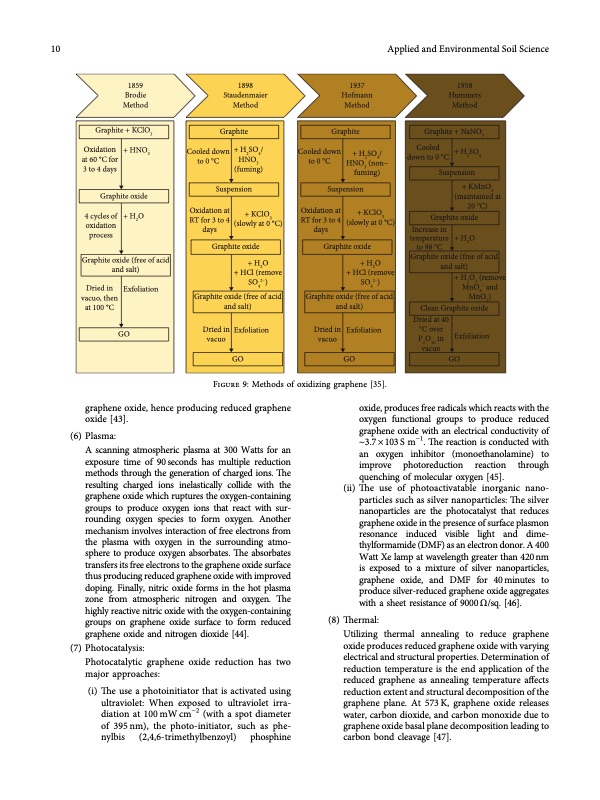PDF Publication Title:
Text from PDF Page: 010
10 Applied and Environmental Soil Science 1859 Brodie Method 1898 Staudenmaier Method 1937 Hofmann Method 1958 Hummers Method Graphite + KClO3 Oxidation at 60 °C for 3 to 4 days + HNO3 Graphite oxide 4 cycles of oxidation process + H2O Graphite oxide (free of acid and salt) Dried in vacuo, then at 100 °C Exfoliation GO Graphite Cooled down to 0 °C + H2SO4/ HNO3 (fuming) Suspension Oxidation at RT for 3 to 4 days + KClO3 (slowly at 0 °C) Graphite oxide + H2O + HCl (remove SO 2–) 4 Graphite oxide (free of acid and salt) Dried in vacuo Exfoliation GO Graphite Cooled down to 0 °C + H2SO4/ HNO3 (non– fuming) Suspension Oxidation at RT for 3 to 4 days + KClO3 (slowly at 0 °C) Graphite oxide + H2O + HCl (remove SO 2–) 4 Graphite oxide (free of acid and salt) Dried in vacuo Exfoliation GO Graphite + NaNO3 Cooled down to 0 °C Suspension Graphite oxide Graphite oxide (free of acid and salt) Clean Graphite oxide Dried at 40 °C over P4O10 in vacuo GO graphene oxide, hence producing reduced graphene oxide [43]. (6) Plasma: A scanning atmospheric plasma at 300 Watts for an exposure time of 90seconds has multiple reduction methods through the generation of charged ions. Te resulting charged ions inelastically collide with the graphene oxide which ruptures the oxygen-containing groups to produce oxygen ions that react with sur- rounding oxygen species to form oxygen. Another mechanism involves interaction of free electrons from the plasma with oxygen in the surrounding atmo- sphere to produce oxygen absorbates. Te absorbates transfers its free electrons to the graphene oxide surface thus producing reduced graphene oxide with improved doping. Finally, nitric oxide forms in the hot plasma zone from atmospheric nitrogen and oxygen. Te highly reactive nitric oxide with the oxygen-containing groups on graphene oxide surface to form reduced graphene oxide and nitrogen dioxide [44]. (7) Photocatalysis: Photocatalytic graphene oxide reduction has two major approaches: (i) Te use a photoinitiator that is activated using ultraviolet: When exposed to ultraviolet irra- diation at 100 mW cm−2 (with a spot diameter of 395nm), the photo-initiator, such as phe- nylbis (2,4,6-trimethylbenzoyl) phosphine oxide, produces free radicals which reacts with the oxygen functional groups to produce reduced graphene oxide with an electrical conductivity of ∼3.7 × 103 S m−1. Te reaction is conducted with an oxygen inhibitor (monoethanolamine) to improve photoreduction reaction through quenching of molecular oxygen [45]. (ii) Te use of photoactivatable inorganic nano- particles such as silver nanoparticles: Te silver nanoparticles are the photocatalyst that reduces graphene oxide in the presence of surface plasmon resonance induced visible light and dime- thylformamide (DMF) as an electron donor. A 400 Watt Xe lamp at wavelength greater than 420 nm is exposed to a mixture of silver nanoparticles, graphene oxide, and DMF for 40 minutes to produce silver-reduced graphene oxide aggregates with a sheet resistance of 9000 Ω/sq. [46]. (8) Termal: Utilizing thermal annealing to reduce graphene oxide produces reduced graphene oxide with varying electrical and structural properties. Determination of reduction temperature is the end application of the reduced graphene as annealing temperature afects reduction extent and structural decomposition of the graphene plane. At 573 K, graphene oxide releases water, carbon dioxide, and carbon monoxide due to graphene oxide basal plane decomposition leading to carbon bond cleavage [47]. Figure 9: Methods of oxidizing graphene [35]. Increase in temperature to 98 °C + H2SO4 + KMnO4 (maintained at 20 °C) + H2O + H2O2 (remove MnO – and 4 MnO2) ExfoliationPDF Image | State-of-the-Art Graphene Synthesis Methods

PDF Search Title:
State-of-the-Art Graphene Synthesis MethodsOriginal File Name Searched:
8475504.pdfDIY PDF Search: Google It | Yahoo | Bing
Salgenx Redox Flow Battery Technology: Power up your energy storage game with Salgenx Salt Water Battery. With its advanced technology, the flow battery provides reliable, scalable, and sustainable energy storage for utility-scale projects. Upgrade to a Salgenx flow battery today and take control of your energy future.
CONTACT TEL: 608-238-6001 Email: greg@infinityturbine.com (Standard Web Page)